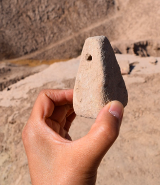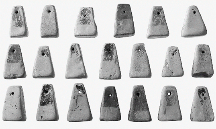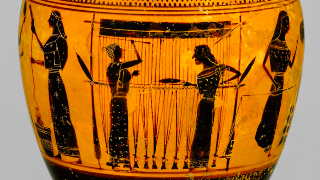Archaic Greek in a modern world, part 2
« previous post | next post »
[This is a guest post from Zhang He]
Dear Colleagues:
I am writing to you at the airport of Termez, a city on the southern border of Uzbekistan with Afghanistan. This city is so far the highest point of my trip. The city’s name is very likely after Demetrius, a general of Alexander the Great, who, after the death of Alexander, ruled this area. There are several important cultures that met here: Greek, Bactrian, Buddhist, and later Islam. A village 20 km north of the city is still called Macedon (!!!) after more than two thousand years! I went to a ruin called Kampir Tepe (Tepe means “hill”) which is believed to be one of the 80+ Alexandrias: Alexandria-Oxus (Alexandria on the Oxus River, which was later called Amu Darya). It was a citadel of Greco-Bactrians from 4th c. BCE to 2nd c. CE. It is believed that Alexander himself and his troops took six days to cross the river and started a settlement here. His third wife Roxana is from a nearby place in today’s Tajikistan (less than 60 miles). I saw big ceramic storage jars. The fragments were laid out on the ground by working archaeologists from more than two thousand years ago! Really amazing!
There are also first and second century CE Kushan dynasty palaces (ruins of course) and several Buddhist stupas and monasteries. Hellenistic style Buddhist statues and column bases and capitals have been found in these ruins. Kushans were nomads coming from northwestern China (Dunhuang, Gansu province, China). Once they settled here, they started to adopt Greek writing, coinage, and art style. They were the ones who first made Buddha in human form. I will show you a statue found in a Buddhist monastery here. [VHM: not included in this post] You can see both Greek and Indian / Gandara styles on it. The artifacts in this period and in this kind of cross-cultural environment are the ones I am looking for for my research project, so I am really excited.
In the central and western parts of the country, there were two other cultural areas: Khorazm (centered in Old Urgench in Turkmenistan, and Khiva in western Uzbekistan), where Iranian speaking people lived and Zoroastrianism was popular; and Sogdiana centered in Samarkand and Bukhara (also called Transoxiana: the area between the Oxus or Amu Darya and Syr Darya), where another Iranian group Sogdians lived.
Once Islam had conquered Central Asia, they built mosques and minarets. The oldest one left in Central Asia today is found here. It is dated 1108. There are overwhelmingly mosques and madrasas (monasteries) in the country. Many were originally built during Timurid time, but now most are reconstructed and repaired only after the Soviet era.
Amir Timur, or Tamerlane, who claimed himself as the descendant of Genghis Khan and was a conqueror of Central and West Asia, Syria, and Egypt, is recognized as a national iconic hero after Uzbekistan’s independence from USSR. His statues and monuments are found almost everywhere. He was born in a place not far from Tashkent. I have been to both his birthplace and his mausoleum.
Babur, one of Timur’s great-great grandsons, became the founder of the Mughal Dynasty in India. To trace Babur’s life was one of my interests for the trip. He was born in Andijan, a city in the eastern part of the Fergana Basin in the northeast of the country.
To be continued. (October 2014)
————
I wish to add another thing to my description of the Kampir Tepe site.
Together with the huge storage urns, I also saw (I almost picked one up) typical Greek loom weights at the site. The first picture is the one I took with the weight in my hand. The second picture is from recent excavations in northern Greece(Tsakirgis 2015) , and the third is a Greek vase painting at Met museum.



[VHM: Very impressive documentation!]
Selected readings
- "Archaic Greek in a modern world" (7/16/22)
- "The Wool Road of Northern Eurasia" (4/12/21) — with a lengthy bibliography on the importance of archeology for historical linguistics
- "What a prehistoric pair of pretty pants can tell us about the spread of early languages" (4/3/21)
- Elizabeth Barber, Women's Work: The First 20,000 Years: Women, Cloth, and Society in Early Times (New York: W. W. Norton, 1994).
- Andrew Sherratt, "The Trans-Eurasian Exchange: The Prehistory of Chinese Relations with the West," in Victor H. Mair, ed., Contact and Exchange in the Ancient World (Honolulu: University of Hawaii Press, 2006), pp. 30-61.
Elizabeth J W Barber said,
July 20, 2022 @ 5:39 pm
What is the date of the No. Greek excavation material? The vase is centuries earlier than Alexander, though it shows their use beautifully. Loomweight shapes do change, though often rather slowly.
Victor Mair said,
July 20, 2022 @ 8:58 pm
Another question from Elizabeth J W Barber:
If you have access to or information about both weights: do they WEIGH about the same? (That tells us something about the fabric being woven.)